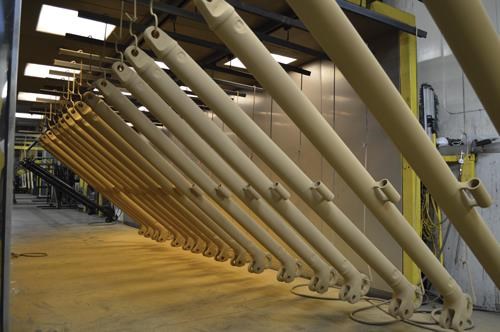Top Shops: Incentivizing Pays Off for Burkard
Training and HR: Burkard Industries, Jay Burkard, President, Clinton Township, MI
#topshops #curing #masking
All companies have a different approach to incentivizing employees, but most agree that the higher the employee engagement, the better the performance and company loyalty.
Burkard Industries’ Jay Burkard knows the value of a precise, data-driven incentive program.
Featured Content
“We have seen about a 20 percent plant-wide increase in productivity over the last 18 months,” he says. “I attribute this improvement to our focus on establishing performance metrics, collecting data and sharing that information with our employees on a daily basis.”
Burkard Industries, a Clinton Township, Michigan-based powder coating and electrocoating company, assesses the company’s four key production departments using a “scorecard” system, which evaluates the company, the departments, the employees and part quality. The company prides itself on being meticulously data-driven, using gathered data to assess the company’s strengths and weaknesses.
The company operates with this system in an effort to meet both company-level and employee-level objectives and encourage the employees to churn out quality material, Burkard says. This creates a more responsive team of employees and encourages stringent focus on creating excellent product.

Weekly Scorecards Track Successes
At the company level, a weekly-company scorecard is measured based on 22 critical parameters that are adherent to SMART (specific, measurable, achievable, relevant, time-based) objectives, which are established at the beginning of every year. The management team then reviews the week’s assessment based on weekly department productivity, company sales, line FTC, A/R days, customer feedback and so on.
At the department level, employees assess their performance for the day with the goal of meeting objectives. Employees are awarded bonuses based on their level of productivity; departments have awarded bonuses as much as $500 monthly to each employee and line leaders are eligible for a $100 weekly bonus based on their previous week’s productivity score.
In Burkard’s e-coat area, individual employee data is based on production records for each job. Each employee is given a “grade” at the end of the week based on his or her performance. That data determines whether an employee performs above or below established standards. If an employee receives a score over 100 percent, they are considered “green,” and any employee that is considered green for four consecutive weeks receives a $100 bonus.
Quarterly, all hourly and salaried employees are evaluated using the scorecard system, which are comprehensive and detailed with the company’s expectations for the employees and how they can improve. This is, essentially, a one-page quarterly performance review based on 10 key factors that Burkard considers core to the business.
Employees are given a “performance incentive,” which is added to their hourly rate based on their most recent reviews.
This system allows employees to assess their own strengths and helps the company determine individual employees’ strengths and weaknesses so they may be worked to their strengths. This method helps increase productivity, employee motivation and gives the employee the ability to earn money based on performance rather than seniority.
“We also paid out about $360,000 in employee performance-based incentives in 2014,” Burkard says. “I expect that to increase to over $400,000 in 2015. The way we use data to manage the business and motivate our employees makes us unique in this industry.”
For more informaton on Burkard Industries, please visit Burkardind.com
— Jess Larkin, Assistant Editor
Originally published in the October 2015 issue.
RELATED CONTENT
-
Plating Q&A: Can you color stainless steel?
Our expert, Art Kushner, says yes, you can color stainless steel, but it is not a process that is typically performed in a plating shop. Read more about his answer.
-
Smut and Desmutting
Question: I am new to this industry and have heard about smut and desmutting operations.
-
Pretreatments: The Next Generation
Emerging technologies can save energy, ease environmental concerns


















